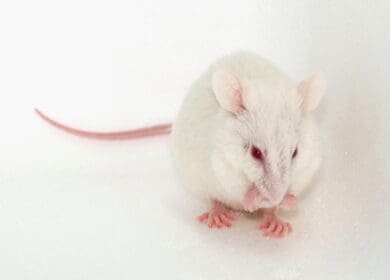SCID
SCID
| Strain details | |
|---|---|
| Nomenclature | C.B-17/IcrHanHsd-Prkdcscid/Ozarc |
| Common name | SCID |
| Synonyms | SCID, CB17 |
| Strain | Mutant inbred |
| Coat Colour | Albino (A/A Tyrp1b/Tyrp1b Tyrc/Tyrc) |
| Species | Mouse |
| Genetic background | - |
| Location | Area Oz1 |
| Weekly wean target | <10 males, <10 females |
Strain description
- MHC haplotype: H2Kd
- Complement factor: C5 normal
- Arose as a spontaneous autosomal recessive mutation in C.B-Igh-1b (CB-17) congenic strain. Prkdcscid (autosomal recessive, protein kinase, DNA activated, catalytic polypeptide).
- Homozygotes have little or no immunoglobulin in serum. Lymphoid organs consist of vascular connective tissue and macrophages and are devoid of lymphocytes.
- Bone marrow lacks plasma cells and lymphocytes and skin lacks dendritic Thy-1+ epidermal cells. Although B and T-cells, pre-B and pre-T cells are absent early B and T-cells are present.
- A variable percentage (2-20%) of young adults develops low numbers of functional B and T-cells. This is not genetically determined.
- Macrophage activation and antigen presentation, NK cell activity and myeloid cell differentiation is normal.
- Thymic lymphomas occur in about 15% of mice.
- Cystitis in female stock.
- This stock strain is housed in an isolator.
- In 1980 at Fox chase Canser Centre this mutation was discovered by Bosma. This mutation occurred in the C.B-17/Icr strain, IgH congenic partner of BALB/cAnIcr differing from it only by a portion of chromosome 12 that was derived from C57BL/Ka strain. In 1989, to Central Institute for Laboratory Animal Breeding, Hannover, Germany. Then to Harlan UK in 1994. Breeders refreshed with mice from Harlan UK Ltd. 2003.
- SCID mice are transferred from Animal Resource Centre to Ozgene ARC in 2023.
- Useful model for studying the relationship between immunity and disease, studies on engraftment of xenogenic cells and tissues, and studying human severe combined immunodeficiency.
- Useful model for understanding the basis of increased lymphoid malignancies in immunodeficiencies as thymic lymphomas occurs in about 15% of mice.
Past ARC and transfer reports:
Current Ozgene ARC reports (from 01-Jun-2023)
- This strain is housed in Area Oz1
- Please see Oz1 health reports on our Biosecurity page
- Animals are not allowed to be used for propagation.
- Ozgene ARC terms and Conditions
- Mouse images are representative only. Actual phenotypes may vary based on genotype, sex, age, husbandry, health status, and other factors.


